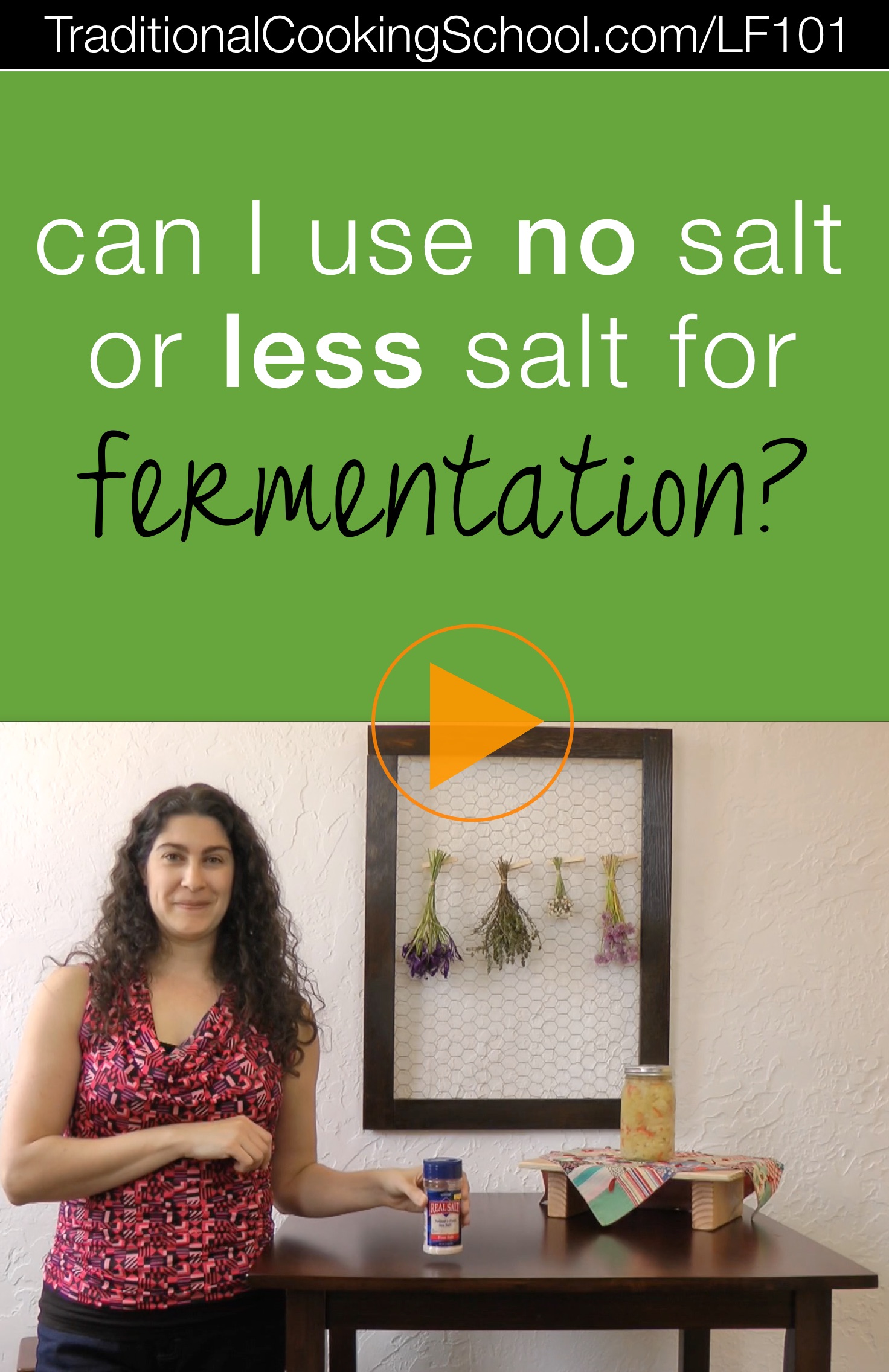
Are you wondering if you can use less salt or salt in fermenting?
As the author of The Complete Idiot’s Guide to Fermenting Foods and through teaching Lacto-Fermentation at Traditional Cooking School, I’ve received lots of questions about fermenting over the years.
Are you wondering how much salt to use, what salt to use, how to store ferments, if fermenting is safe, or other fermenting questions? This video series will answer them!
The Lacto-Fermentation 101 Video series today covers…
Can I Use Less Salt or No Salt for Fermentation?
Some are on low-salt diets and wonder: Is it possible to ferment without salt? I don’t recommend it. The salt is key to creating an environment where the ferment is protected from spoiling.
You can use less salt (like reduce by 25% to 50%) but you must use a starter culture to ensure a successful ferment. I recommend: Homesteader Supply Veggie Starter Culture, Body Ecology Starter Culture, or Caldwell’s Starter Culture.
No matter what, choose your salt carefully. REAL, unrefined salt is a completely different food than the conventional table salt that causes lots of health problems for so many.
REAL salt is a whole food containing trace minerals and other substances our bodies need for optimum health. On the other hand, iodized table salt from the grocery store is regarded by our bodies as poison. Bottom line: Use unrefined, real salt for fermenting. I recommend Real Salt from Redmond or Himalayan pink salt, among others.
For more fermentation questions, check out Fermentation Troubleshooting & FAQs.
Links Mentioned
- Free Fermenting Formulas Cheat Sheet
- The Complete Idiot’s Guide to Fermenting Foods
- Subscribe to TCS on YouTube
- Lacto-Fermentation eBook
- Lacto-Fermentation eCourse at Traditional Cooking School
- Redmond Real Salt
- Himalayan Sea Salt
- Celtic Sea Salt
- Homesteader Supply Veggie Starter Culture
- Body Ecology Starter Culture
- Caldwell’s Starter Culture
...without giving up the foods you love or spending all day in the kitchen!

2 free books:
Eat God's Way
Ditch the Standard American Diet, get healthier & happier, and save money on groceries...
We only recommend products and services we wholeheartedly endorse. This post may contain special links through which we earn a small commission if you make a purchase (though your price is the same).


I use only Himilayan Pink Salt, and pure sea salt in my cooking and ferments. I found several bags of the pink salt at a discount store for only a couple of dollars. Grabbed them all.
I found another fermentation website that recommends a 2% brine (roughly equivalent to 3/4 teaspoon salt per cup of water) to top off self brining ferments like krauts. It recommends sprinkling roughly 1 teaspoon of salt on veggies for every pound of kraut, then topping it off with the 2% brine to submerge the veggies. This is considerably less salt then I have been using (1 tablespoon of salt per cup of water) in addition to roughly 3 tablespoons directly on the kraut for about 3 heads of cabbage plus 1 pound of carrots , but would love to have a less salty ferment since my husband is on a low salt diet. I always use a starter culture. What do you think of the recommendation with lower salt?
Thanks! Lisa
Actually, I grew up in a household that fermented sauerkraut by the vatfull in earthenware pots in our basement during the winter. My dad comes from a long line of Southern Europeans who all did this as a matter of course. He did use salt. However, his ferments were ‘wild’–they were more or less left ‘open–yeah, they had cheesecloth over the top and a board and weighted rocks. But, other than that he had very little control over the actual growth of the ferment, hence the need for so much salt.
I learned my fermentation technique through the Body Ecology Diet and I use ZERO salt. The secret is I have a carefully designed process to prevent contamination (everything is sterilized, before and during) and I use a truly anaerobic fermentation crock. I don’t do ‘wild fermenting’ because the overwhelming scientific evidence points to the fact that you have little control of good or bad when you do that showing up in your ferment–even if you do use salt. My dad would usually have to go in and ‘scrape the slime and mold’ off the top of the ferment and change the cheesecloth. I was always ending up with bad ferments in the past when I was using salt and using a ‘wild ferment’ method (just basic canning jars). I got sick of wasting money on organic cabbage and wasting effort and time. So, I started my current process. Up until recently I also NEVER used a starter kit or anything like that. I didn’t need to. I still don’t need to. Sometimes I put in some probiotics just to give things a bit more of a ‘kick’ but it’s not necessarily. I have some of the cleanest, healthiest, strongest and most flavorful (and effective) sauerkraut many of my family and friends have ever eaten. So, yeah, do what you want but for me I never use salt. I rarely use any other starters and I use a very precise, sterile preparation method coupled with a truly anaerobic fermenting crock.
I read somewhere that you can use celery juice. Have you heard of this ?
Hi Janet,
Celery juice is an alternative to nitrates in preserving meats (such as sausages or hot dogs). We have not heard of it as an alternative in fermenting.
Millie
Traditional Cooking School